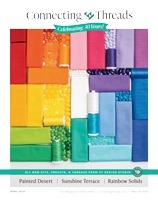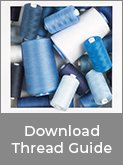A Guide to Thread
by Teri Stillwell

Which thread do I use? This is a common question that springs to mind when shopping for thread and you are confronted with a mass of spools containing different fibers and weights in rainbows of colors. Cotton, polyester, rayon, silk, oh my! Here is some information on the most common threads used for quilting by machine to help you navigate through the thread mine field.
Cotton Thread: Also known as spun thread. It’s called this because you spin lengths of fiber called staples into plies then the plies are twisted together. Spun threads have a fuzzy surface which is what makes it soft to the touch and gives it a more matte finish.
Cotton threads are measured by thread count number and plies. The thread count is the thickness of each strand. The ply denotes how many strands of thread are wound together to make the thread. General cotton sewing thread used in sewing machines and is usually 50/3, such as our Essential Cotton Thread, where the thread thickness is 50 and there are 3 strands of thread woven together make the plies; or 40/2 which is essentially the same size but thicker thread with less plies. Hand Quilting thread is generally 40/3 which is thicker than machine sewing thread although this can also be used for machine quilting. You can also buy extra thin specialty thread that is for your bobbin which is 60/2. The higher the first number the thinner the thread.
Cotton thread generally has a matte finish and comes in a wide variety of colors although the colors that sell the most are usually neutrals since that is what most quilters piece with. The best cotton thread uses long staple fibers and is mercerized. This reduces the “hairiness” of the thread, gives it strength, and helps the dye absorb properly. If you are creating an heirloom piece and are concerned about your thread and fabric aging at the same rate, then using cotton thread with cotton fabric is a good idea. Cotton will wear more than synthetic threads and isn’t as colorfast. It can also be linty so you need to be sure to clean out your machines. You can often find cotton thread pre-wound in bobbins that is great for use in your machines but can also give you a sampling of colors to use for applique.

Polyester Thread: Polyester thread can be spun or continuous filament. Spun polyester thread is made the same way as cotton. Spun thread isn’t as strong as monofilament thread which is one continuous filament. Our Essential Polyester Thread is continuous filament.
You can get polyester in a variety of weights (generally 40 weight for embroidery or quilting and 60 weight for applique and bobbin), colors, and finishes (such as matte or high sheen) that are good for general sewing, quilting, embroidery, serging, and other decorative stitching.
Polyester is generally strong, durable, and colorfast. Since it’s one continuous filament it isn’t “linty” like cotton, however that means it isn’t as soft and because of this can cut your cotton fabric over time as it doesn’t wear at the same rate. This is really only a worry if you are making an heirloom quilt you want to last for generations. If you are making a ‘for everyday use’ project, polyester will do just fine and in some cases where you want the quilting to show up more, it will do better. Because it is stronger it will sink down into the fabric a little more and give your quilting a little more definition.

Nylon: Nylon thread is another continuous filament created from one single filament of nylon. You would use a very fine thread such as .004 or .005 for quilting. It’s also referred to as invisible thread because it’s so fine. Nylon thread comes in clear and dark and works well for applique as well as machine quilting where you don’t want your thread to show. You have to be careful when ironing projects using this thread as it has low heat resistance and can become brittle and yellow.
Rayon: Threads that are made with rayon tend to be filament but there are a few exceptions where the thread is core-spun (rayon thread wrapped around polyester). Rayon threads come in many sizes, although 40 weight is most commonly used, are usually high sheen, and are used for decorative stitching and embroidery. You can also use them for serging and couching but they are not as strong as polyester.
Silk: Good silk thread is filament. This makes it strong and a good natural fiber alternative to polyester. 100 weight silk thread works well for applique making your stitches almost invisible. You can also get this in thicker weights if you want your stitches to show.
Remember like anything else thread can age, so if you have thread that is really old, test it before you start your project because it can break more easily as it ages. I always use a little sticker and put the color name on it and the date I purchased the thread. I use that to keep my strand in place when I am not using the thread so it doesn’t get tangled and that way I also have the color name, since once I’ve taken the packaging off it is gone. Another good idea I’ve seen is using a golf tee to keep your thread and matching bobbins together. Shop Thread at Co









